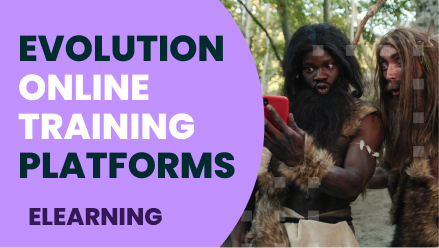From the beginning, e-learning has had a clear goal: to be an educational system that is accessible to everyone, regardless of age, language, geographic location, etc.
New technologies have played a fundamental role in the evolution of online training, enabling this training model through educational platforms known as LMS (Learning Management Systems).
E-learning concept
We know the importance of e-learning as a learning model based on education through online training platforms.
The term “e-learning” was created by Elliott Masie at the TechLearn conference in November 1999.
On many occasions, similar terms such as tele-training, distance learning, virtual teaching, and online training are heard, all of which have similar meanings.
Origin of elearning, first platforms
In the 1990s, the first terms LMS and virtual campus appeared, which took steps to establish themselves in the teaching-learning models we know today.
In the 2000s, they began positioning themselves as a complement and alternative to classroom or traditional training.
This is how we know blended learning, which combines both models to provide a more complete training experience.

Elearning today
Progress continues to be made. Virtual training is no longer just a system of education but has become a part of those companies looking for solutions to develop the talent of their employees.
LMSs currently have practical and effective resources to strengthen the skills of those who use them. A few of these resources are listed below.
Own contents
Creating personalized content that is tailored to the end user creates a special connection with students, which drives participation, completion, and overall satisfaction.
Microlearning
The use of training pills facilitates the learning process and minimizes the time spent on training or presenting information to users.
Content Gamification
Gamifying learning content turns boring and monotonous tasks into an exciting experience. It is the key to motivating users and achieving training goals.
Videos
Having short resources, such as 2-3 minute videos, with clear and concise information allows the user to absorb and retain the information more easily.

The future of e-learning
As experts in virtual training, we keep pace with the evolution of digital education. In our article on Trends in eLearning 2023, we talked to you about where digital education is headed.
Undoubtedly, the trend that will have the greatest impact in the coming years is the Metaverse and Artificial Intelligence (AI) as complementary technologies.
Metaverse and learning
Metaverse applications will implement realistic experiences with theoretical learning. Users can solve real-world problems in a virtual environment, developing problem-solving skills for real-world situations.
Artificial intelligence in education
Artificial intelligence will be the key to creating more realistic and detailed virtual environments.
Similarly, in the metaverse, AI can help create personalized content for users based on their interests.





